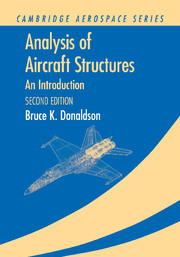Book contents
- Frontmatter
- Contents
- Introduction to the Second Edition
- Introduction to the First Edition
- List of Repeated Engineering Symbols
- Acknowledgments
- Part I The Fundamentals of Structural Analysis
- Part II **Introduction to the Theory of Elasticity**
- Part III Engineering Theory for Straight, Long Beams
- Part IV Work and Energy Principles
- Part V Energy-Based Numerical Solutions
- Part VI Thin Plate Theory and Structural Stability
- 22 Thin Plate Theory
- 23 Elastic and Aeroelastic Instabilities
- Appendix A Additional Topics
- Appendix B Selected Answers to Exercises
- References
- Index
23 - Elastic and Aeroelastic Instabilities
from Part VI - Thin Plate Theory and Structural Stability
Published online by Cambridge University Press: 05 June 2012
- Frontmatter
- Contents
- Introduction to the Second Edition
- Introduction to the First Edition
- List of Repeated Engineering Symbols
- Acknowledgments
- Part I The Fundamentals of Structural Analysis
- Part II **Introduction to the Theory of Elasticity**
- Part III Engineering Theory for Straight, Long Beams
- Part IV Work and Energy Principles
- Part V Energy-Based Numerical Solutions
- Part VI Thin Plate Theory and Structural Stability
- 22 Thin Plate Theory
- 23 Elastic and Aeroelastic Instabilities
- Appendix A Additional Topics
- Appendix B Selected Answers to Exercises
- References
- Index
Summary
Introduction
The Euler beam buckling type of elastic instability, where an entire beam axis moves laterally, is discussed in Sections 11.6 and 11.7. Plate buckling and local flange and web type beam buckling are discussed in Section 22.8. These previous elastic instability discussions centered upon the solution of appropriate differential equations. In the first part of this chapter the focus is upon the use of the finite element method to calculate elastic buckling loads. The use of the finite element method makes practical the elastic buckling analysis of structures as opposed to the buckling analysis of one or two isolated structural elements. These FEM beam buckling solutions have the same limits of applicability as the Euler beam buckling solutions.
The second part of this chapter examines certain instabilities of structures that arise from fluid–structure interactions. These instabilities have much in common with the purely elastic instabilities. Whereas the object of an elastic instability analysis is to discover the critical magnitude of a particular type of load that will cause a sudden and sizable lateral deflection of the elastic structure, the object of the aeroelastic analysis is to discover the critical value of the airspeed (or Reynolds number or Mach number) beyond which the airloads cause an ever increasing deflection or vibration amplitude. A representative static instability (divergence) and a representative dynamic instability (wing flutter) are studied in some detail. Again the FEM is useful for describing the linear elastic properties of the structure being studied.
- Type
- Chapter
- Information
- Analysis of Aircraft StructuresAn Introduction, pp. 792 - 838Publisher: Cambridge University PressPrint publication year: 2008



